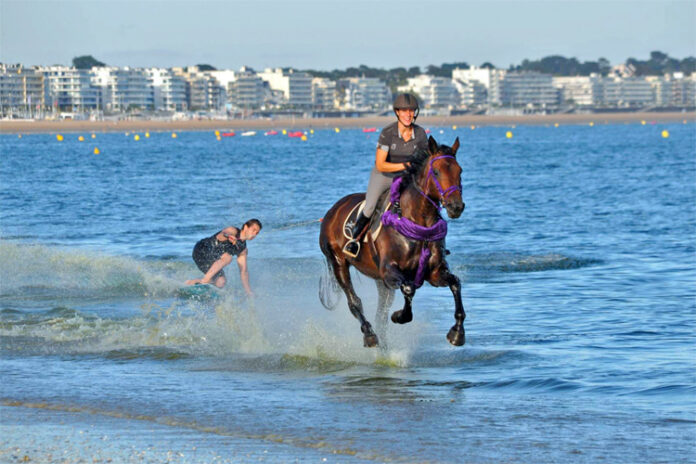It’s definitely a different equestrian experience and surely an unusual way of riding a board across the water. Here’s everything you need to know about horse surfing.
Horse surfing is a sport that involves surfing or riding a surfboard, skimboard, wakeboard, or kiteboard behind a horse.
A tow rope fixed to a custom-built saddle on the back of a horse allows the surf rider to speed across the water or near the shoreline.
Depending on the type of board used, the tide and overall ocean conditions, and the beach topography, riders may also perform tricks and maneuvers in small, near-shore breaking waves.
The sport, also known as horse boarding, is the modern version of chariot racing that promises one of the most exciting and uncommon outdoor activities.

The Origins of Horse Surfing
Horse surfing was invented in 2004 by Daniel Fowler-Prime and Matt Smith, two English horsemen from Cornwall, England.
Fowler-Prime, who was also a passionate skater, decided to try and tow a mountainboard behind a horse.
One year later, he was commissioned to do a trick riding shoot at a beach but forgot the mountainboard.
So, Daniel visited a local surf shop and asked the manager if he could bring a mountainboard and a wakeboard to the photoshoot site.
Matt Smith, the store manager, agreed, and the stunt was a success.
The pictures taken on that day were quite impressive and were soon making headlines all around the world.
Horse surfing had become a new sport.
In 2006, kiteboarder Harold Quinquis ran the first-ever horse surfing contest in La Baul, France. The event also included a horse boarding drag race.
A couple of years later, both disciplines were featured at the Skegness X-Fest under the rules of the Extreme Horse Riding Association, an organization founded by Daniel Fowler-Prime.
The National Horseboarding Championships saw the light of day in the following years, and the sport grew in popularity.
Today, Horseboarding UK is an active British association with plenty of competitions and activities for equestrian and boardsports enthusiasts.
Where and How
Horse surfing can be practiced and enjoyed in oceans and rivers, but also inland in countryside race tracks.
If you live by the sea, all you need to do is ask a skilled horse rider to tow you as you grab the rope and use a board to accelerate across water or grass.
Horse surfers can easily reach speeds of up to 40 miles per hour (64 kilometers per hour), so wearing a helmet is important.
If you live in an area surrounded by green fields, make sure you get the standard and specifically designed four-wheeled skate for rolling across the grass.
However, it is advisable to enroll in a horse boarding course in order to master the basic riding techniques behind a horse.
Today, horse surfing is a reality, here and there, all over the world.
There are participants surfing behind horses in England, France, Australia, the United States, Taiwan, and even Dubai.
Obviously, the sport requires an ocean, lake, or river that is deep enough for a board to glide across the water’s surface and simultaneously shallow enough for the horse to gallop through.
Crowded beaches are not recommended, and horse riders should avoid galloping over sensitive dunes and natural reserves.
The ideal horse racing arena is, at least, from 300 to 400 yards in length.
Horses should be trained to ride on beaches, at low tide, and be comfortable in the water. Otherwise, they might start feeling anxious and agitated.
Riding on wet sand is also more strenuous, so make sure the horse takes a break once in a while.
After each session, it is mandatory to rinse the horse with fresh water to remove the salt and sand grains from its skin.
Horse surfing competitions have rules – a maximum length for the course, four disciplines, safety procedures, video analysis, judgment criteria, etc.
Believe it or not, the horse boarding industry is growing and extremely active, with multiple world championships taking place, specialized magazines, and highly competitive teams.
According to the world’s best horse surfers, the hardest part is actually taking off. And can they pull off freestyle tricks? Of “horse.”





